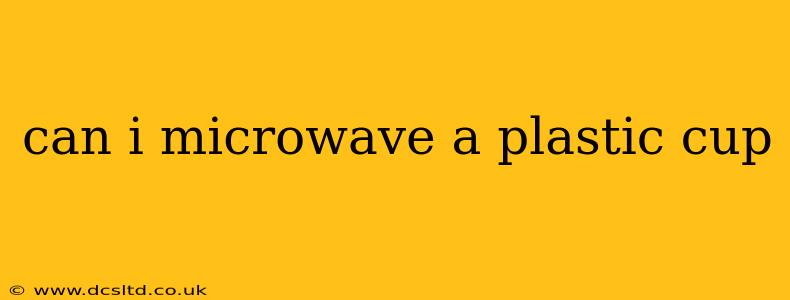Can I Microwave a Plastic Cup? A Comprehensive Guide to Microwave-Safe Plastics
The simple answer to "Can I microwave a plastic cup?" is: it depends. Not all plastic is created equal, and microwaving the wrong type can be dangerous, potentially leaching harmful chemicals into your food and even causing the cup to melt or warp. Understanding the different types of plastic and their microwave suitability is crucial.
What Types of Plastic Are Microwave-Safe?
The key is looking for the recycling symbol on the bottom of the cup, usually a number inside a triangle. Not all numbers indicate microwave safety, however.
-
#5 PP (Polypropylene): This is generally considered microwave-safe, though it's best to avoid extremely high temperatures and prolonged heating. Look for cups specifically labeled as "microwave-safe."
-
#2 HDPE (High-Density Polyethylene): While generally considered safe for cold foods and drinks, HDPE is usually not recommended for microwaving.
-
#1 PETE (Polyethylene Terephthalate): This is commonly used for soda bottles and is definitely not suitable for microwaving. Repeated heating can cause it to break down and release harmful chemicals.
-
#3 PVC (Polyvinyl Chloride): This is rarely used for cups and is absolutely not microwave-safe. Avoid it altogether.
-
#4 LDPE (Low-Density Polyethylene): Similar to HDPE, this is not typically recommended for microwaving.
-
#6 PS (Polystyrene): This is the common plastic used in styrofoam cups and should never be microwaved. It can melt and release harmful chemicals.
-
#7 Other: This category encompasses a variety of plastics, and microwave safety varies greatly. Always check the manufacturer's instructions.
In short: Only plastic cups explicitly labeled as "microwave-safe" should be used in the microwave. Even then, use caution and avoid extreme temperatures or prolonged heating.
What Happens If I Microwave a Non-Microwave-Safe Plastic Cup?
Microwaving non-microwave-safe plastics can lead to several undesirable outcomes:
-
Chemical Leaching: Harmful chemicals can leach from the plastic into your food or drink, potentially affecting your health.
-
Melting or Warping: The plastic can melt, warp, or even catch fire, potentially causing damage to your microwave.
-
Odor and Taste: Your food or drink may acquire an unpleasant odor or taste from the plastic.
How Can I Tell If My Plastic Cup Is Microwave-Safe?
The most reliable method is to check the label. Look for a clear indication that it's safe for microwave use. If there's no label, or if it's unclear, err on the side of caution and avoid using it in the microwave. Glass or ceramic mugs are always a safer alternative.
Are There Any Alternatives to Plastic Cups for Microwaving?
Yes! Consider these safer options:
-
Glass mugs: These are excellent for microwaving and are generally reusable and durable.
-
Ceramic mugs: Similar to glass, ceramic mugs are microwave-safe and easy to clean.
-
Microwave-safe plastic containers: Specifically designed for microwaving, these containers are a good alternative for leftovers.
By following these guidelines and understanding the different types of plastics, you can safely heat your beverages and avoid potential health risks associated with microwaving unsuitable plastics. Remember, when in doubt, throw it out!
